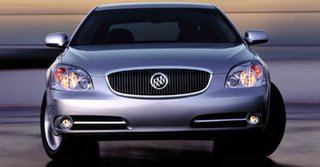LUCERNE: MORE THAN JUST A BUICK!

From AUTOWEEK, By Kevin A. Wilson
Published Date: 11/7/05
On sale: Now. Base Price: $27,715. Powertrain: 3.8-liter, 197-hp, 227-lb-ft V6; fwd, four-speed automatic. Curb Weight: 3764 lbs. 0 to 60 mph: 8.4 seconds (est.). Fuel Mileage (EPA combined): 22 mpg
Ever since the Toyota Avalon arrived in 1994, car writers have called the big sedan “the best Buick money can buy,” playing around with variations on the old ad campaign that proclaimed “When better Buicks are built, Buick will build them.”
Funny stuff. If you’re toiling for Buick, though, you have to admit the ads invited satire. That has to sting.
Finally, after years of little more than wan grimaces in response, General Motors looks to be fighting back. Buick offered both a 2005 Avalon and its front-drive platform mate, the Lexus ES 330, for direct back-to-back comparison with the new 2006 Lucerne. This model replaces both the LeSabre and Park Avenue in struggling Buick’s rationalized car range, just as the LaCrosse (Allure in Canada) replaces both the Century and Regal.
The new big Buick is named for a city in Switzerland, and our passenger on this first drive of the Lucerne was a big Swiss-born fellow named Bob Lutz, vice chairman of General Motors, who began by telling us his personal, chauffeur-driven ride is a DTS, but that he is swapping the Caddy for a Lucerne.
The Cadillac and Buick are built on the same platform, the G-body that has underpinned some of GM’s best front-drive sedans for years. The Lucerne is offered with either a 3.8-liter 197-hp V6 or the 275-hp 290-lb-ft Northstar V8 (the first V8 offered in a Buick car in 10 years).
Lucerne’s body sports lines borrowed from the Velite concept car. Once you get past the Buick waterfall grille, it has a Lexus-like look to it, and the comparison goes deeper. Fit-and-finish is excellent, the standard safety equipment is world-class, and the Buick is quieter than the Toyota-built cars offered for comparison.
The cabin is up to snuff. The Lucerne uses high-quality materials and is screwed together properly, with an aesthetic appeal that, while hardly cutting-edge, is not so old-school as the LeSabre or the Park Avenue.
Then there is the driving. On GM’s challenging ride and handling test loop at Milford and then over some of the better test roads in southern Michigan, the Lucerne proved imperturbable. Like an Avalon or ES 330, it’s no sport sedan, but if you’re in a hurry you can lean on a Lucerne and it won’t let you down.
At the proving ground we sampled cars with Magnetic Ride Control, using the fast-acting, electronically controlled variable shock absorbers that damp out road-induced motions. Okay, we thought, but that old Buick float will be trouble in the twisties if you don’tget the Magnetic Ride Control. Then we hit the open road, and threw a Northstar-equipped Lucerne with the standard suspension into a couple of corners. It was unflustered. No wallow, no foul. Its back-road demeanor reminded us of the last Oldsmobile Aurora, a car that didn’t deserve to die with its marque.
Sure, we would rather be in a sports car or even a sportier sedan on that kind of road, but an Avalon isn’t any better suited to the task than is the new Buick, and the Magnetic Ride Control option would tilt the comparison toward GM’s car.
So, is Toyota still building the best Buick sold in America? We will have to offer that as an idea for our DoubleTake test folks (who tend not to leap at the chance to compare yawnmobiles), but Lucerne is a strong enough contender that the Avalon is no longer a shoo-in, and that is a big change in itself.
Lucerne is built at GM’s Hamtramck, Michigan plant. Remember, the object of comparison isn’t some Toyota at the end of its product cycle and destined to be replaced soon, but the third-generation Avalon recently introduced. Lucerne is priced aggressively, with a nicely equipped V8 model coming in at a sweet spot of around $32,000.
“The Buick loyalists, whether they trade a LeSabre or a Park, will be ecstatic,” predicted Lutz. Harder to forecast is whether the car can win back customers lost to Toyota.
Expecting to do so assumes such customers are unhappy enough to leave Toyota, and there is not much evidence on that score. Any reconquest would also depend on the buyer’s favorable impressions of the local Buick dealer’s service. Those are some big assumptions—there is more to this game than making good cars.
But making good cars is where it has to start, and the Lucerne looks and drives like a lot more than just a better Buick.

0 Comments:
Post a Comment
<< Home